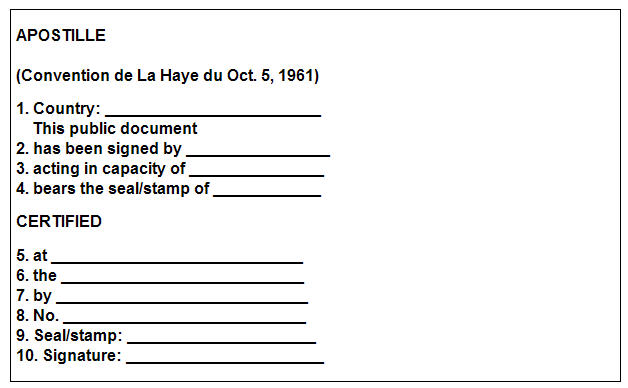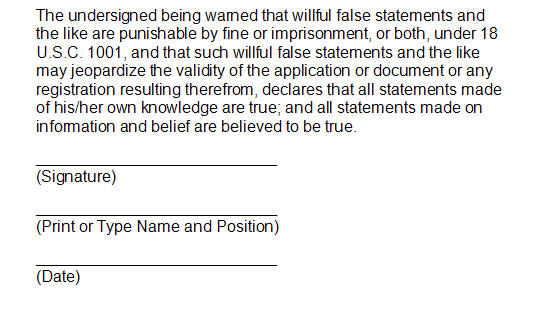804.01 Form and Wording of Verification in §1 or §44 Application
The format of the verification in an application under §1 or §44 of the Trademark Act may be: (1) the classical form for verifying, which includes an oath (jurat) (see TMEP §804.01(a)); or (2) a declaration under 37 C.F.R. §2.20 or 28 U.S.C. §1746 instead of an oath (see TMEP §804.01(b)).
804.01(a) Verification with Oath
The verification is placed at the end of the application. It should first set forth the venue; followed by the signer’s name (or the words "the undersigned"); then the necessary statements (TMEP §804.02); concluding with the signature. After the signature, there should be the jurat for the officer administering the oath, and an indication of the officer’s authority (such as notarial seal).
The form of the verification depends on the law of the jurisdiction where the document is executed, so variations of the above form are acceptable. If there is a question as to the validity of the verification, the examining attorney should ask the applicant if the verification complies with the laws of the applicant’s jurisdiction. See TMEP §804.01(a)(i) regarding verifications made in a foreign country.
If the verification is notarized but does not include the notarial seal, the examining attorney must require a substitute affidavit or declaration under 37 C.F.R. §2.20.
If the verification is notarized but has not been dated, the applicant must submit either a statement from the notary public attesting to the date of signature and notarization, or a substitute affidavit or declaration under 37 C.F.R. §2.20.
804.01(a)(i) Verification Made in Foreign Country
Verification (with oath) made in a foreign country may be made: (1) before any diplomatic or consular officer of the United States; or (2) before any official authorized to administer oaths in the foreign country. In those foreign countries that are members of The Hague Convention Abolishing the Requirement of Legislation for Foreign Public Documents, a document verified before a foreign official should bear or have appended to it an apostille (i.e., a certificate issued by an official of the member country).
Member countries, territories, and Departments in Europe participating in this Convention are: Anqulla, Antigua & Barbuda, Argentina, Armenia, Australia, Austria, Bahamas, Bailiwick of Guernsey, Barbados, Belarus, Belgium, Belize, Bermuda, Bosnia & Herzegovina, Botswana, British Antarctic, British Guiana (Guyana), British Soloman Islands, Cayman, Croatia, Cyprus, Dominica, El Salvador, Falkland Islands, Figi, Finland, France, French Guiana, Germany, Gibraltar, Gilbert & Ellice Islands (Kiribati), Greece, Grenada, Guadeloupe, Hong Kong, Hungary, Isle of Man, Jersey, Israel, Italy, Japan, Latvia, Lesotho, Liechtenstein, Lithuania, Luxembourg, Macedonia, Malawi, Malta, Marshall Islands, Martinique, Mauritius, Mexico, Montserrat, Netherlands, New Hebrides (Vanuatu), Norway, Panama, Portugal, Reunion, Saint Christopher & Nevis, Saint Helena, Saint Lucia, Saint Vincent, San Marino, Seychelles, Slovenia, South Africa, Southern Rhodesia (Zimbabwe), Spain, Suriname, Swaziland, Switzerland, Tonga, Turkey, Turks & Caicos, United Kingdom & Northern Ireland, and the Virgin Islands.
An apostille must be square shaped with sides at least 9 centimeters long. The following is the prescribed form for an apostille:

See notice at 1013 TMOG 3 (December 1, 1981).
If a verification is made before a foreign official in a country that is not a member of the Hague Convention, the foreign official’s authority must be proved by a certificate of a diplomatic or consular officer of the United States. 15 U.S.C. §1061.
Declarations under 37 C.F.R. §2.20 and 28 U.S.C. §1746 by foreign persons do not have to be made before a United States diplomatic or consular officer, or before a foreign official authorized to administer oaths. A declaration under 28 U.S.C. §1746 that is executed outside the United States must allege that "I declare (or certify, verify, or state) under penalty of perjury under the laws of the United States of America that the foregoing is true and correct." See TMEP §804.01(b).
See http://www.state.gov/www/authenticate/index.html for updated information about the Hague Convention.
804.01(b) Declaration in Lieu of Oath
Under 35 U.S.C. §25, the USPTO is authorized to accept a declaration under 37 C.F.R. §2.20 or 28 U.S.C. §1746 instead of an oath. These declarations can be used whenever the Act or rules require that a document be verified or under oath.
When the language of 37 C.F.R. §2.20 or 28 U.S.C. §1746 is used with a document, the document is said to have been subscribed to (signed) by a written declaration rather than verified by oath (jurat).
When a declaration is used in lieu of an oath, the party must include in place of the oath (jurat) the statement that "all statements made of his or her own knowledge are true and all statements made on information and belief are believed to be true." Preferably, this language is placed at the end of the document.
In addition, the declaration must warn the declarant that willful false statements and the like are punishable by fine or imprisonment, or both (18 U.S.C. §1001). 35 U.S.C. §25(b). Trademark Rule 2.20 requires that the warning contain the additional language that such statements may jeopardize the validity of the application (or document) or any registration resulting therefrom. A declaration under 37 C.F.R. §2.20 should read as follows:

Instead of using the language of 37 C.F.R. §2.20, an applicant may use the language of 28 U.S.C. §1746, which provides as follows:
Wherever, under any law of the United States or under any rule, regulation, order, or requirement made pursuant to law, any matter is required or permitted to be supported, evidenced, established, or proved by the sworn declaration, verification, certificate, statement, oath, or affidavit, in writing of the person making the same (other than a deposition, or an oath of office, or an oath required to be taken before a specific official other than a notary public), such matter may, with like force and effect, be supported, evidenced, established, or proved by the unsworn declaration, certificate, verification, or statement, in writing of such person which is subscribed by him, as true under penalty of perjury, and dated, in substantially the following form:
- 1 If executed outside the United States, its territories, possessions, or commonwealths: "I declare (or certify, verify, or state) under penalty of perjury under the laws of the United States of America that the foregoing is true and correct. Executed on (date).
(Signature)".
- 2 If executed within the United States, its territories, possessions, or commonwealths: "I declare (or certify, verify, or state) under penalty of perjury that the foregoing is true and correct. Executed on (date).
(Signature)".
NOTE: Title 35 of the United States Code pertains specifically to the USPTO and, therefore, is preferred to 28 U.S.C. §1746, which is a statute of general application relating to verification on penalty of perjury.
A declaration that does not attest to an awareness of the penalty for perjury is unacceptable. 35 U.S.C. §25. In re Hoffmann-La Roche Inc., 25 USPQ2d 1539 (Comm’r Pats. 1992) (failure to include a statement attesting to an awareness of the penalty for perjury, which is the very essence of an oath, is not a "minor defect" that can be provisionally accepted under 35 U.S.C. §26), overruled on other grounds, In re Moisture Jamzz Inc., 47 USPQ2d 1762, 1764 (1997); In re Stromsholmens Mekaniska Verkstad AB, 228 USPQ 968 (TTAB 1986); In re Laboratories Goupil, S.A., 197 USPQ 689 (Comm’r Pats. 1977).
The signatory must personally sign his or her name. It is unacceptable for a person to sign another person’s name to a declaration pursuant to a general power of attorney. See In re Dermahose Inc., 82 USPQ2d 1793 (TTAB 2007); In re Cowan, 18 USPQ2d 1407 (Comm’r Pats. 1990). In a TEAS submission, the person(s) identified as the signer(s) must manually enter the elements of the electronic signature. The rules do not provide authority for an attorney to sign another person's declaration. Dermahose, 82 USPQ2d at 1795. See TMEP §611.01(c) regarding signature of documents filed through TEAS.
If a declaration under 37 C.F.R. §2.20 or 28 U.S.C. §1746 is not dated, the examining attorney must require the applicant to state the date on which the declaration was signed. This statement does not have to be verified, and may be entered through a Note to the File in the record.
See TMEP §804.02 regarding the essential allegations required to verify an application for registration of a mark.